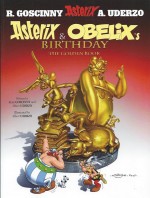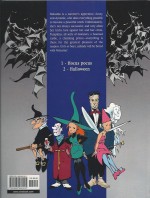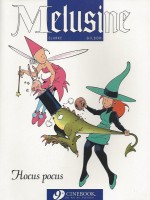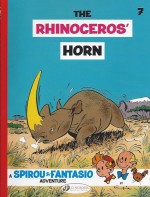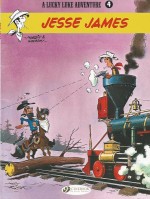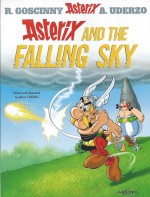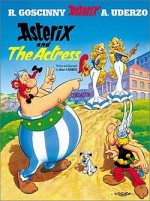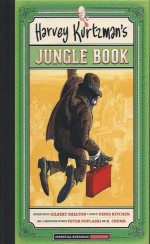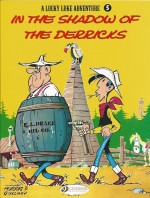
By Morris & Goscinny, translated by Luke Spear (Cinebook)
ISBN: 978-1-905460-17-5
Lucky Luke is a rangy, good-natured, lightning-fast quick-draw cowboy who roams the fabulously mythic Old West on his super-smart horse Jolly Jumper, having light-hearted adventures and interacting with a host of historical and legendary figures of the genre.
He’s probably the most popular Western star still active in the world today. His unbroken string of exploits over nearly seventy years has made him one of the best-selling comic characters in Europe (81 albums selling in excess of 300 million copies in 30 languages thus far), with spin-off toys, computer games, animated cartoons and even a plethora of TV shows and live-action movies.
He was created in 1946 by Belgian animator, illustrator and cartoonist Maurice de Bévère (“Morrisâ€) for the 1947 Annual (L’Almanach Spirou 1947) of Le Journal de Spirou, before launching into his first weekly adventure ‘Arizona 1880’ on December 7th 1946.
Prior to that, Morris met future comics super-stars Franquin and Peyo while working at the CBA (Compagnie Belge d’Actualitiés) cartoon studio and contributing caricatures to weekly magazine Le Moustique.
Morris quickly became one of “la Bande des quatre†(The Gang of Four) which comprised creators Jijé, Will and Franquin: the leading proponents of the loose and free-wheeling artistic style known as the “Marcinelle School†which dominated Spirou in aesthetic contention with the “Ligne Claire†style used by Hergé, EP Jacobs and other artists in Tintin Magazine.
In 1948 said Gang (all but Will) visited America, meeting US creators and sightseeing. Morris stayed for six years, meeting fellow traveller René Goscinny, scoring some work from newly-formed EC sensation Mad and making copious notes and sketches of the swiftly vanishing Old West. That research resonates on every page of his life’s work.
Working solo until 1955, Morris produced another nine albums worth of affectionate sagebrush parody before teaming up with Goscinny, who became the regular wordsmith. Luke rapidly attained the dizzying heights of superstardom, commencing with ‘Des rails sur la Prairie’ (Rails on the Prairie), which began in Spirou on August 25th 1955.
In 1967 the six-gun straight-shooter switched teams, transferring to Goscinny’s own magazine Pilote with ‘La Diligence’ (The Stagecoach). Goscinny produced 45 albums with Morris before his death in 1977, after which Morris continued both singly and with fresh collaborators.
Morris died in 2001 having drawn fully 70 adventures, plus the spin-off adventures of Rantanplan (“dumbest dog in the West†and a charming spoof of cinema canine Rin-Tin-Tin), after which Achdé, Laurent Gerra, Benacquista & Pennac took over the franchise, producing another five tales to date.
Moreover, apart from the initial adventure, Lucky (to appropriate a quote applied to the thematically simpatico Alias Smith and Jones) “in all that time… never shot or killed anyoneâ€â€¦
Lucky Luke first appeared in Britain syndicated to weekly comic Film Fun and reappeared in 1967 in Giggle where he was renamed Buck Bingo. In all these venues – as well as the numerous attempts to follow the English-language successes of Tintin and Asterix albums from Brockhampton and Knight Books – Luke had a trademark cigarette hanging insouciantly from his lip, but in 1983 Morris, no doubt amidst both pained howls and muted mutterings of “political correctness gone madâ€, substituted a piece of straw for the much-travelled dog-end, which garnered him an official tip of the hat from the World Health Organization.
The most successful attempt at bringing Lucky Luke to our shores and shelves is the most recent. Cinebook (who have rightly restored the foul weed to his lips on the interior pages if not the covers…) have translated 53 albums thus far. In the Shadow of the Derricks was the fifth, now available both on paper and as an e-book edition.
As À l’ombre des derricks, it was first published in 1962: the 18th European release and Goscinny’s ninth collaboration with Morris. It’s also one of the team’s many tales blending historical personages with their wandering hero’s action-comedy exploits and as such it’s a wry condemnation of the oil business both in terms of unchecked commercial adventurism and ecological impact and one of the earliest negative opinions of the trade in comics…
It all begins with a little history lesson on how a toxic contaminant farmers once hated and dreaded finding on their land rapidly became a treasured commodity able to turn rational souls into greed-crazed prospecting zombies, after pioneer Edwin Laurentine Drake (popularly known as Colonel Drake and notoriously renowned as the first man to drill for oil in America) set up shop in Titusville, Pennsylvania in 1857.
Two years later his invention of the “Oil Derrick†triggers the first oil rush in history and prospectors come from far and wide to cash in on the new bonanza mineral. Terrified of the inrush of ne’er-do-wells and chancers, the Titusville City Council quickly telegraph for the greatest cowboy lawman in the world to come protect them…
By the time Lucky Luke rides in, the little city is a fetid sinkhole of greed and corruption which looks and smells as bad as it acts. The dignitaries who summoned him are now as enamoured of “black gold†as any transient prospector and the Deputy Mayor’s last official duty is to give Luke his sheriff’s badge before joining the deranged digging fraternity.
The crowning indignity comes when a passing prospector stops him from lighting a cigarette. The oil fumes are so prevalent and pernicious that one match might eradicate the entire town!
Setting to work, Lucky heads for the saloon and is accosted by a gang of thugs. The brutish Bingle is intent on scaring the lawman off but has completely underestimated his opponent…
Hauling the defeated desperado to jail Luke meets the only man in town immune to oil-fever. Old Sam Jigs loathes what the evil muck has made of his town and is happy to watch Bingle while Lucky goes to inspect Colonel Drake’s installation, meeting also the celebrity’s ingenious engineer Billy Smith.
The Colonel takes the sheriff on a tour of various claims and working wells, imploring him to try and restore some order to the wild and wicked region. However all the current fighting, feuding and wildcatting is as nothing to the growing depredations of smooth, slick, oily Texan lawyer Barry Blunt whom Luke first encounters when he stops a lynching.
The legal weasel has a plan to own every well in America and knows enough lawful dodges to trick or force all the other prospectors out of business before they’ve even begun. This is a new kind of opponent for the straight-shooter, who normally holds the Law in great esteem…
Blunt is inexorably forcing the independents to leave or sell up to him; his legion of legal wrangles and small-print scams backed up by a gang of ruthless cutthroats. One such is Bingle, whom the shady shyster tries to spring from jail, only to find that his hulking heavy doesn’t want to leave. He’s already struck oil while digging an escape tunnel…
When prospectors who won’t sell or quit start experiencing devastating oil-fires and unemployed townsfolk sell themselves into virtual slavery in Barry’s growing enterprises it’s time for drastic action, and Luke resolves to start using the spirit rather the letter of the law…
Soon Barry is in jail on trumped up charges and the villain shows his true colours. Busting out and setting the entire region ablaze, Blunt proves himself a suicidal madman: if he can’t own the oil, nobody will…
After the final showdown Lucky and Jolly Jumper resign, heading back home extremely relieved that goofy old Texas doesn’t have to put up with idiot oil hunters…
Cleverly barbed, wickedly ironic and spectacularly cynical, this witty romp is another grand old hoot in the tradition of Destry Rides Again and Support Your Local Sheriff (perhaps Paint Your Wagon, Evil Roy Slade or Cat Ballou are more your style?), superbly executed by master storytellers as a wonderful introduction to a unique genre for today’s kids who might well have missed the romantic allure of an all-pervasive Wild West that never was…
And in case you’re worried, even though the interior art still has our hero chawin’ on that ol’ nicotine stick, trust me, there’s very little chance of anyone craving a quick snout, but quite a strong probability that they’ll be addicted to Lucky Luke Albums…
© Dargaud Editeur Paris 1971 by Goscinny & Morris. © Lucky Comics.
English translation © 2007 Cinebook Ltd.

